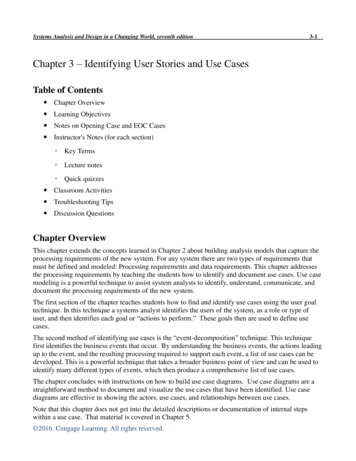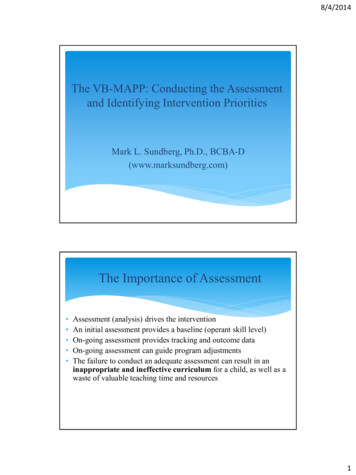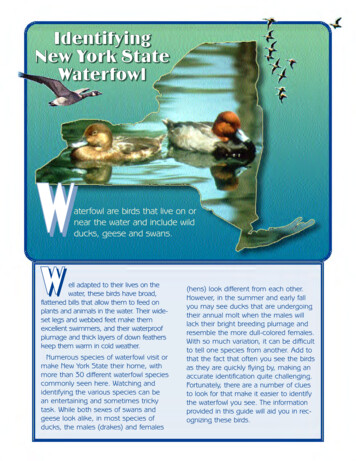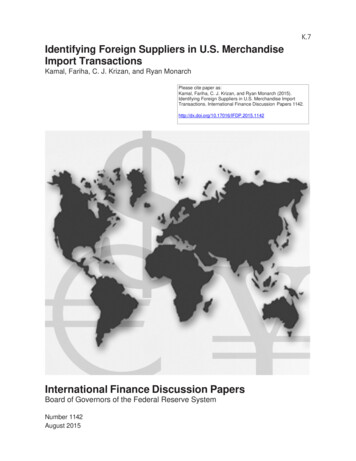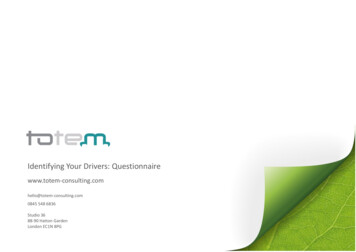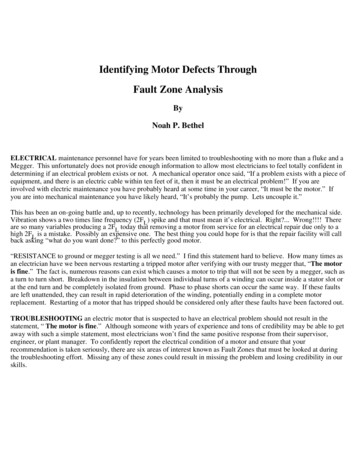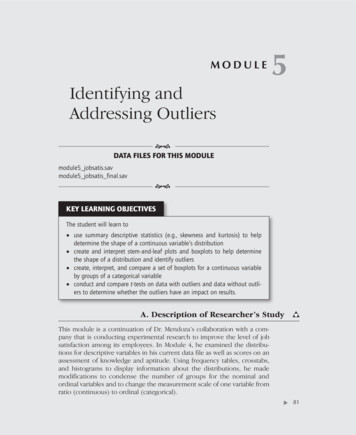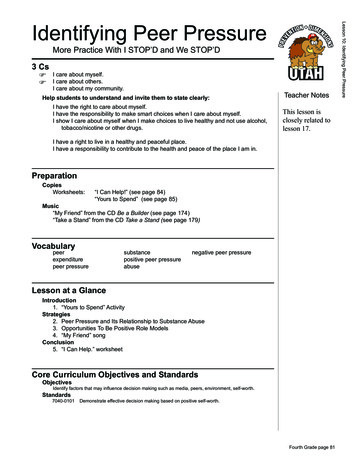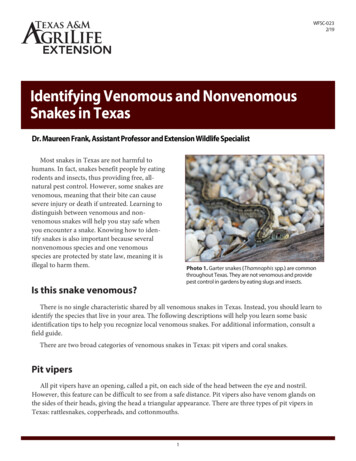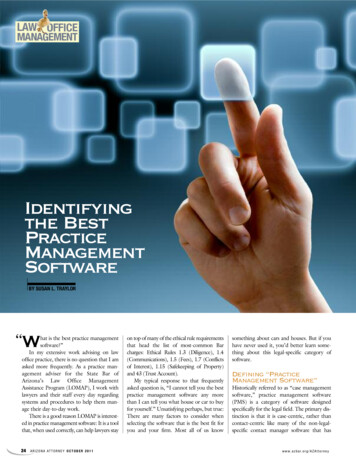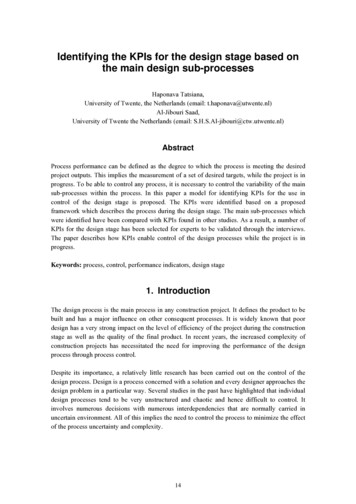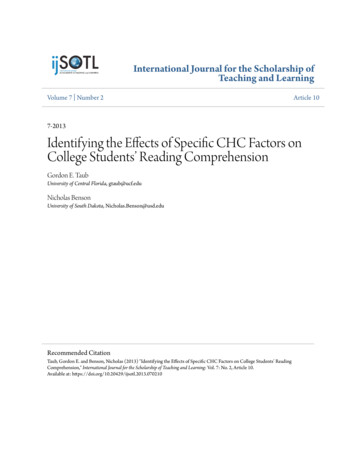
Transcription
International Journal for the Scholarship ofTeaching and LearningVolume 7 Number 2Article 107-2013Identifying the Effects of Specific CHC Factors onCollege Students’ Reading ComprehensionGordon E. TaubUniversity of Central Florida, gtaub@ucf.eduNicholas BensonUniversity of South Dakota, Nicholas.Benson@usd.eduRecommended CitationTaub, Gordon E. and Benson, Nicholas (2013) "Identifying the Effects of Specific CHC Factors on College Students’ ReadingComprehension," International Journal for the Scholarship of Teaching and Learning: Vol. 7: No. 2, Article 10.Available at: https://doi.org/10.20429/ijsotl.2013.070210
Identifying the Effects of Specific CHC Factors on College Students’Reading ComprehensionAbstractReading comprehension is an important skill for college academic success. Much of the research pertaining toreading in general, and reading comprehension specifically, focuses on the success of primary and secondaryschool-age students. The present study goes beyond previous research by extending such investigation to thereading comprehension of college-age student participants. Using the Cattell-Horn-Carroll (CHC) theoreticalmodel, this study investigates the effects of seven broad factors on the reading comprehension of college-agestudents. Of the seven broad factors identified within the CHC theoretical model, only crystallizedintelligence and visual-spatial thinking demonstrate statistically significant direct effects on readingcomprehension. Although crystallized intelligence consistently has been identified as playing an integral rolein the reading comprehension of primary and secondary school-age students, this study represents the firsttime visual-spatial thinking has been found to have a statistically significant direct effect on readingcomprehension, in any population. This study provides hypotheses to explain the effects of visual-spatialthinking on college-age students’ reading comprehension and offers instructional strategies to assist faculty inimproving student learning in higher education settings.KeywordsCHC factors, Reading comprehension
IJ-SoTL, Vol. 7 [2013], No. 2, Art. 10Identifying the Effects of Specific CHC Factorson College Students’ Reading ComprehensionGordon E. Taub Universityof Central Florida Orlando,Florida, USA gtaub@ucf.eduNicholas Benson Universityof South Dakota Vermillion,South Dakota, USAnicholas.benson@usd.eduAbstractReading comprehension is an important skill for college academic success. Much of theresearch pertaining to reading in general, and reading comprehension specifically, focuseson the success of primary and secondary school-age students. The present study goesbeyond previous research by extending such investigation to the reading comprehension ofcollege-age student participants. Using the Cattell-Horn-Carroll (CHC) theoretical model,this study investigates the effects of seven broad factors on the reading comprehension ofcollege-age students. Of the seven broad factors identified within the CHC theoreticalmodel, only crystallized intelligence and visual-spatial thinking demonstrate statisticallysignificant direct effects on reading comprehension. Although crystallized intelligenceconsistently has been identified as playing an integral role in the reading comprehension ofprimary and secondary school-age students, this study represents the first time visualspatial thinking has been found to have a statistically significant direct effect on readingcomprehension, in any population. This study provides hypotheses to explain the effects ofvisual-spatial thinking on college-age students’ reading comprehension and offersinstructional strategies to assist faculty in improving student learning in higher educationsettings.IntroductionReading is one of the most import skills for college success, yet not all students areaccomplished readers. In an effort to advance empirical knowledge and assist educationprofessionals, many researchers have investigated the relative effects of specific areas ofintelligence on students’ reading performance. Much of this research, however, has beenconducted within contexts that lack consistent theoretical modeling and constructidentification (Floyd, Keith, Taub, & Mc Grew 2007). The lack of a common theoreticalframework and nomenclature to account for the constellation of specific areas orcomponents of intelligence important for reading success, across studies, makes organizingresults from diverse publications difficult. Although a common nomenclature has not beenused to describe the components of intelligence essential for reading success, it appearsthat researchers consistently identify five specific broad areas responsible for readingsuccess. These five areas are: auditory processing, memory, 2101
Identifying the Effects of Specific CHC Factorvocabulary/comprehension, and visual-spatial processing (e.g., Hoskyn & Swanson, 2000;Kuhn & Stahl, 2003; Stuebing et al., 2002).The first area, auditory processing, is believed to be important in auditory discrimination,perception, and the manipulation of sound (Keith, 1999; Lonigan, Burgess, & Anthony,2000; Scarborough & Brady, 2002). The second area important to successful reading ismemory. This component is responsible for tasks that include retention of information inimmediate awareness and mental manipulation of words and sounds; this is also referred toas immediate memory, phonological memory, and working memory (e.g., McGrew, Flanagan,Keith, & Vanderwood, 1997; Swanson, 2000; Wagner, et al., 1997). Third is a mentalretrieval component. This component is involved in accessing previously acquired knowledgeand in activities requiring speed in accessing information, such as serial naming, rapidautomatized naming, phonological retrieval, and rate of access (Tiu, Thompson & Lewis,2003; Wolfe, Bowers, & Biddle, 2000). The vocabulary/ comprehension as area consists ofword knowledge, verbal intelligence, syntactical knowledge, semantic processing, language,receptive vocabulary, and verbal reasoning (e.g., Butler, Marsh, Sheppard, & Sheppard,1985; de Jong & van der Leij, 1999). Finally, the visual-spatial area is referred to asalphabetic coding, letter-identification, orthography, and visual discrimination (Chall,1996; Kuhn & Stahl, 2003).The five areas of intelligence identified above can be classified into five broad factors withina contemporary theory of intelligence. The Cattell-Horn-Carroll (CHC) theoretical model ofintelligence offers a comprehensive framework and nomenclature which may assist withintegrating results across studies. Applying a consistent theoretical framework andnomenclature may also help educators understand relations between areas of intelligence,which are labeled as broad cognitive factors in CHC nomenclature, and reading achievement(e.g., Floyd et al., 2007).Potential benefits from research identifying the relationship between CHC factors andreading comprehension include improved curricula and student learning; core outcomeswithin the scholarship of teaching and learning (Hutchings, Huber, & Ciccone, 2011). Sinceall students are not accomplished readers, identifying strategies to accommodate studentswho display difficulty with reading comprehension assists faculty as they apply strategies toimprove their teaching and instruction. This is the tradition of research in the scholarship ofteaching and learning, to expand discipline-based knowledge in an effort to enhanceeducation (Burke, Johnson, & Kemp, 2010). Strategies to improve learning outcomesinclude those that increase students’ opportunity to learn or reduce the time needed tolearn (Bloom, 1968). Although any learning requires the opportunity to learn, time alone isnot sufficient to ensure mastery of a task, instructional unit, or curriculum (Carroll, 1989). Itis what goes on during this time that makes the difference. Thus a key goal of this study isto identify strategies faculty may apply to enhance student learning as well as approachesstudents may use to improve learning outcomes.Cattell-Horn-Carroll TheoryThe CHC theoretical model is considered one of the most empirically supported andtheoretically sound models of intelligence (Carroll, 1993; 2003; Flanagan, McGrew & Ortiz,2000; McGrew & Wendling, 2010; McGrew & Flanagan 1998; Stankov, 2000). The CHChttps://doi.org/10.20429/ijsotl.2013.0702102
IJ-SoTL, Vol. 7 [2013], No. 2, Art. 10model is hierarchical in nature. The CHC model places the general factor of intelligence, g, atits highest level. The second level consists of seven broad factors (i.e., seven separate areasof intelligence). The seven broad factors located at the second level of the CHC modelinclude auditory processing, crystallized intelligence, fluid reasoning, long-term retrieval,processing speed, short-term memory, and visual-spatial thinking. A brief description ofeach of the seven CHC broad factors is presented in Table 1. The CHC model provides acommon nomenclature for educators, practitioners, and researchers to use when discussingareas of intelligence and their relationship with the acquisition and maintenance of academicknowledge and skills (McGrew 1997; McGrew & Wendling, 2010). In keeping with the CHCnomenclature, the five areas previously identified as important in reading achievement arethe broad CHC factors: auditory processing (e.g., auditory discrimination, perception, andthe manipulation of sound), short-term memory (e.g., immediate memory, phonologicalmemory, and working memory), long-term retrieval (e.g., accessing previously acquiredknowledge), crystallized intelligence (e.g., word knowledge, verbal intelligence, syntacticalknowledge, semantic processing), and visual-spatial thinking (e.g., visual discrimination),respectively.Table 1. Descriptions of the Seven Cattel-Horn-Carroll (CHC) Broad FactorsCHC FactorDescriptionAuditory ProcessingAnalyze, discriminate, and synthesizeauditory stimuliCrystallized IntelligenceThe depth and breadth of an individual’sacquired knowledge, the communication ofthis knowledge, and to reason usingpreviously learned experiences orprocedures.Fluid ReasoningSolveing problems using inductive anddeductive reasoning as well as formingconcepts using novel or unfamiliarinformation or proceduresLong-Term RetrievalThe storage, retrieval, and use concepts orfacts fluently from memoryProcessing SpeedSpeed of mental processing under conditionsrequiring sustained attention andconcentration, cognitive 2103
Identifying the Effects of Specific CHC FactorShort-term memoryThe conscious holding of information,storage of information, and use ofinformation within a few seconds (includesworking memory capacity)Visual-spatial thinkingAnalyzing, perceiving, synthesizing andthinking with visual stimuli including theability to store and recall visualrepresentationsPurpose of the StudyThe purpose of the present study is threefold. The first purpose is to go beyond earlierinvestigations by using structural equation modeling (SEM) to identify the effects of theseven CHC broad factors and general intelligence on reading comprehension. The secondpurpose is to extend research examining the effects of these factors on the readingcomprehension of college-age students. The third purpose is to extend the results from thisstudy in reading comprehension and CHC theory to improve student learning.MethodParticipantsParticipants in this study were drawn from one of five age groups within the WoodcockJohnson III’s (WJ III) standardization sample (Woodcock, McGrew & Mather, 2001). The ageof participants ranged from 20 to 39 (n 1423). Thus, the sample is representative oftraditional students who have completed at least one year of college as well as nontraditional students through age 39.InstrumentsTest indicators for the study consisted of 4 tests from the WJ III Tests of Achievement(ACH) 18 tests from the WJ III Tests of Cognitive Abilities (COG) and 5 tests from the WJ IIIDiagnostic Supplement (Woodcock, McGrew, Mather, & Schrank, 2003).The Passage Comprehension and Reading Vocabulary tests from the WJ III ACH served asindicators of the dependent variable, reading comprehension. The Passage Comprehensiontest required participants to read and comprehend contextual information while the ReadingVocabulary test required participants to use synonyms, use anonyms, and solve analogies.Data AnalysisThe AMOS 7.0 (Arbuckle, 2007) statistical program was used to conduct all SEM analyses.Input data were the correlations and standard deviations of scores. Participants wererandomly divided into two separate subsamples as recommended by MacCallum, Roznowski,Mar, and Reith (1994). Dividing the sample permitted the use of one dataset for modelgeneration and calibration, whereas the second dataset was used for model cross-https://doi.org/10.20429/ijsotl.2013.0702104
IJ-SoTL, Vol. 7 [2013], No. 2, Art. 10validation. Employing independent calibration and validation datasets provides results whichare more stable and replicable.Models. The CHC model used in this investigation is presented in Figure 1. The CHC modelis hierarchical in nature. Tests presented on the left side of Figure 1 serve as indicators ofthe seven CHC broad factors. General intelligence (g) is present at the apex of the model.As can be seen, there are at least three different indicators (tests) for each of the sevenCHC factors presented in Figure 1. Three indicators per factor are used to ensure adequateconstruct representation for data analysis purposes. The dependent variable, readingcomprehension, is located on the right side of Figure 1. The SEM measurement modelpresented in Figure 1 is consistent with previous research and has empirical support (e.g.,Floyd et al., 2007; McGrew & Woodcock, 2001; Taub & McGrew, 2004).https://doi.org/10.20429/ijsotl.2013.0702105
Identifying the Effects of Specific CHC FactorFigure 1. The standardized path coefficients of the validation model for the college-age sample'sscores on reading comprehension. Ga auditory processing, Gc crystallized intelligence, Gf fluidreasoning, Glr long-term retreieval, Gs processing speed, Gsm short-term memory,Gv visual-spatial thinking, g general 0702106
IJ-SoTL, Vol. 7 [2013], No. 2, Art. 10Analysis. In the first Phase of the analysis, Phase 1, the calibration data was used for initialmodel estimation. This provides an opportunity to evaluate and identify the combination ofCHC broad factors that are statistically significant predictors of the dependent variable,reading comprehension. Analyses were conducted in stages. During the first stage, abaseline model was identified. The baseline model included all structural paths presented inFigure 1. After baseline model generation, all structural paths with critical values below 1.96(p .05) or paths with negative values were removed. Eliminating paths with low criticalvalues and negative values resulted in the generation of a new model. The new model onlycontained paths above the critical threshold and positive values. In the next stage, themodel was re-estimated, after which an examination of modification indices was conductedto evaluate the need to add any of the eliminated paths. The process of removing all pathswith low critical values and all negative paths and estimating the new model was conducteduntil a final model was obtained that contained only positive paths with values above thecritical threshold. In Phase 2, the validation phase, the final model generated from Phase 1was cross-validated using the independent validation dataset (MacCallum et al., 1994).ResultsThis study examined the effects of the seven CHC broad factors and a general intelligencefactor on participants’ reading comprehension. The study consisted of two phases, Phase 1,a calibration phase and Phase 2, a validation phase. Two datasets were analyzed, one ineach phase of the study. The calibration dataset was used for initial model generation andspecification. Several goodness of fit indices were examined to provide evidence of the fit ofthe final model to the data. These fit indices include the comparative fit index (CFI), rootmean square error of approximation (RMSEA), and the Tucker-Lewis index (TLI). Lowervalues on the RMSEA indicate a better fit to the model. In contrast, higher scores on the CFIand TLI indicate a better fit of the model to the data, with 1.0 indicating a perfect fit (Byrne,2001).The goodness of fit indices for participants’ scores using the calibration dataset on theRMSEA, CFI, and TLI are .065, .842, and .826, respectively. The best calibration datasetmodel identified during Phase 1 was validated using an independent validation dataset inPhase 2. Results of the final analysis using the validation dataset, presented in Figure 1,indicated that all structural paths were statistically significant. Goodness of fit indices alsowere examined to provide evidence of the fit of the final model to the data. The goodness offit indices on the validation dataset for the college-age participants’ scores on the RMSEA,CFI, and TLI are .067, .848, and .833, respectively and indicate an adequate fit of themodel to the data. The results from this study indicate that the CHC-based broad factorscrystallized intelligence and visual-spatial thinking were the only factors having a directeffect on the reading comprehension dependent variable. The effect of general intelligenceon reading comprehension was indirect. The direct effect of crystallized intelligence onreading comprehension was .35 while the direct effect of visual-spatial thinking on readingcomprehension was .60.https://doi.org/10.20429/ijsotl.2013.0702107
Identifying the Effects of Specific CHC FactorDiscussionThe purpose of this study was threefold. The first purpose was to go beyond earlierinvestigations by using SEM to identify which of the seven CHC broad factors are mostimportant in reading comprehension. The second purpose was to extend research in theeffects of the CHC-based factors to include college-age students’ performance on readingcomprehension activities. The final purpose of the study is to extend the results fromresearch in CHC theory and reading comprehension to improve student learning.Results from this study indicate that the CHC-based factors crystallized intelligence andvisual-spatial thinking have statistically significant direct effects on reading comprehension.There is a strong body of research linking crystallized intelligence and verbal ability (e.g,lexical processing, language development) with reading achievement (e.g., Dufva, Niemi, &Voeten, 2001; Evans, Floyd, McGrew, & Leforgee, 2002; Floyd et al, 2007; Vellutino,Scanlon, & Lyon, 2000). Crystallized intelligence represents the depth and breadth of one’sknowledge, whereas reading comprehension requires the acquisition of declarative andprocedural knowledge, thus there is a logical connection between the two.Previous research also found a strong and consistent relationship between crystallizedintelligence and reading achievement of participants ages 9 to 19 (e.g., Benson, 2010;Evans et al., 2002; 2007; Keith, 1999; McGrew et al., 1997; McGrew & Hessler, 1995).Thus, it was not surprising to find that crystallized intelligence was statistically related tocollege-age students’ reading comprehension.In a previous research investigating the effect of CHC broad factors and g on basic readingskills, visual-spatial thinking was not identified as a statistically significant CHC factor. Thisis consistent with other (non CHC-based) research investigating the relationship betweenabilities generally associated with visual-spatial processing and reading (eg., Nation, Clarke,& Snowling, 2002).It is important to note that CHC theory includes seven broad factors or areas of intelligence.The model used in this study included all seve
intelligence and visual-spatial thinking demonstrate statistically significant direct effects on reading . storage of information, and use of information within a few seconds (includes working memory capacity) Visual
